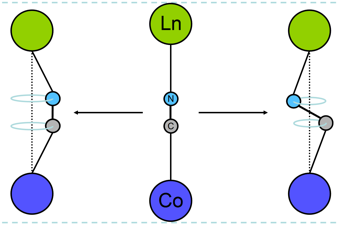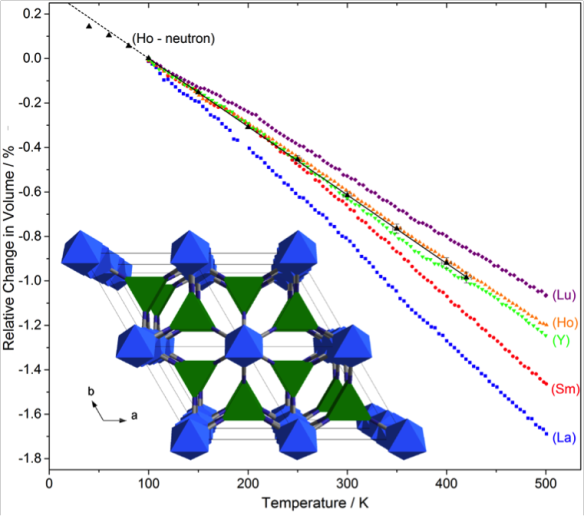Shrinking in the heat – lanthanoid hexacyanidocobaltates, a.k.a. LnCo(CN)6
While most materials expand when heated, a few show the opposite behaviour, known as negative thermal expansion (NTE). The record holder, which has the greatest rate of volume contraction upon warming over a wide temperature range, is single-network cadmium cyanide (we previously blogged about the double-network version). This unusual phenomenon is useful – if you combine an NTE material with a normal material in just the right ratio, you can make a mixture with zero thermal expansion. Such a composite is immune to the undesirable effects of thermal expansion, from the buckling of railway tracks in the heat, to quartz-crystal clocks gaining or losing time when it's too hot or cold.
A related group of frameworks which also show NTE are the lanthanoid hexacyanidocobaltates, with chemical formula LnCo(CN)6, where Ln can be any element from the lanthanoid row of the Periodic Table from lanthanum (La) to lutetium (Lu), Co is cobalt, and CN is cyanide. The cyanide is tightly bound to the cobalt, so these materials aren't particularly toxic, unlike potassium cyanide. They can be easily crystallised from a solution as shown in this time-lapse video, recorded over the course of a few hours.
LaCo(CN)6·5H2O is easy to grow, and forms nice hexagonal crystals. By the end of the video, they are about 2 mm in size and have started to merge together. Once the water is removed from the crystal structure by heating, the NTE properties are activated.
The key to the NTE is the networked structure of the materials. The lanthanoid and cobalt atoms are 'bridged' together by the cyanide (CN) ions. As the temperature rises, these linkers start to vibrate more and more in skipping-rope-like transverse (sideways) vibrations. Just like the ends of a skipping rope get closer together when you vibrate it, these transverse motions cause the average metal-metal distances to decrease, thereby causing contraction of the crystal.

The LnCo(CN)6 frameworks' lanthanoid and cobalt metal atoms are linked together by cyanide bridges. 'Skipping rope' transverse thermal vibrations of these bridges bring the metal atoms closer together and cause the contraction of the whole material as it heats up.
Crystallography (powder diffraction in this case) allows the dimensions of the unit cell to be precisely measured, which lets us monitor the thermal expansion of materials by taking diffraction measurements at a number of different temperatures. The results for a series of LnCo(CN)6 compounds are shown in the plot below, and demonstrate that we can tune the NTE properties just by making the material with different lanthanoid metals. Swapping Lu for La doubles the steepness of the plot. This is because La bonds more loosely to the cyanide linkers than Lu does, making a more flexible framework with bigger transverse vibrations, and therefore bigger NTE.

The crystal structure of LaCo(CN)6 is made up of trigonal prismatic lanthanum (green) and octahedral cobalt (blue) metal atoms linked together by cyanide bridges (grey/blue). The plot shows the negative thermal expansion (NTE) behaviour of several different LnCo(CN)6 frameworks (with Ln = La, Sm, Y, Ho and Lu) measured using X-ray powder diffraction at the Advanced Photon Source. Larger lanthanoid metals, such as La, give a more flexible framework and a stronger NTE effect. The neutron diffraction measurements (black) allow us to go to lower temperatures, revealing how the NTE behaviour dies out, deviating from the nice straight line as the transverse vibrational modes "freeze out". These results were published in S.G. Duyker et al. (2013), Angew. Chem. Int. Ed., 52: 5266–5270.






